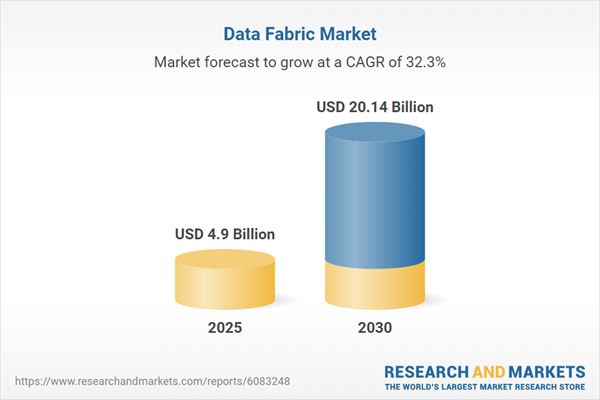Speak directly to the analyst to clarify any post sales queries you may have.
As enterprises accelerate digital modernization, the data fabric market is enabling leaders to drive operational continuity, secure compliance, and maximize actionable insight through unified architecture—a crucial step for future-ready organizations navigating complexity.
Market Snapshot: Growth Trajectory of the Data Fabric Market
The data fabric market recorded robust growth, expanding from USD 3.75 billion in 2024 to USD 4.90 billion in 2025, with a projected CAGR of 32.30%. By 2030, the sector is expected to reach USD 20.14 billion. This remarkable trajectory is driven by surging enterprise data volumes, increasing regulatory scrutiny, and heightened focus on dissolving operational silos. As organizations move away from legacy data models, data fabric solutions have rapidly become foundational elements for modern data strategies. Their inherent modularity and support for open standards help businesses manage risk and adapt flexibly, allowing senior executives to respond swiftly as priorities evolve in the digital economy.
Scope & Segmentation
This analysis provides an in-depth perspective on the current data fabric ecosystem, outlining strategic investment areas and guiding business leaders through the full technology value chain and global implementation landscape. Included segmentation covers critical aspects influencing growth and solution selection:
- Component: Managed services, professional services, data integration, orchestration, security capabilities, data lineage, master data management, metadata management, and data governance—all vital for robust oversight and enterprise scalability.
- Data Type: Structured and unstructured data, delivering broad analytical reach and actionable perspectives across diverse enterprise sources.
- Deployment Mode: Cloud and on-premise options, supporting variable security, scalability, and operational requirements for diverse business environments.
- Organization Size: Solutions for both large enterprises and small-to-medium enterprises (SMEs), each requiring distinctive approaches for deployment and ongoing management.
- Application: Enables AI and machine learning models, process optimization, enhanced customer experience, data warehouses and lakes, operational intelligence, fraud management, real-time analytics, governance, and IoT scenarios.
- Vertical: Key sectors addressed include banking and financial services, education, energy, public sector, healthcare, IT and telecom, manufacturing, media, retail, transportation, and logistics.
- Region: Comprehensive global coverage: Americas (United States, Canada, Mexico, Brazil, Argentina, Chile, Colombia, Peru); Europe, Middle East & Africa (UK, Germany, France, Russia, Italy, Spain, Netherlands, Sweden, Poland, Switzerland, UAE, Saudi Arabia, Qatar, Turkey, Israel, South Africa, Nigeria, Egypt, Kenya); Asia-Pacific (China, India, Japan, Australia, South Korea, Indonesia, Thailand, Malaysia, Singapore, Taiwan).
- Key Vendors: Cisco Systems, Dell, Denodo Technologies, Hewlett Packard Enterprise, HEXstream, Hitachi, IDERA, Salesforce, IBM, Netapp, Nexla, Oracle, Precisely Holdings, SAP, SCIKIQ, Starburst Data, Stardog Union, QlikTech International, Teradata, Cloud Software Group, Microsoft, Cloudera, Google LLC by Alphabet, Amazon Web Services.
Key Takeaways for Strategic Decision-Makers
- Unified data governance frameworks strongly support ongoing business agility and timely insight delivery across dynamic organizational landscapes.
- Integrating AI and machine learning into orchestration streamlines operational resilience, helping enforce policies and automate responses in real time throughout the data lifecycle.
- Hybrid cloud and edge deployments enable flexible workload distribution, easily adapting to local regulatory constraints and global business requirements.
- Distinct industry needs—for example, regulatory and risk in financial services, IoT adoption in manufacturing, and stringent patient data safeguarding in healthcare—influence both solution design and partnership strategies.
- Open-source solutions and alliances with regional providers reduce reliance on proprietary platforms, aiding cost management and mitigating cross-border supply chain vulnerabilities.
Tariff Impact: Navigating Global Trade Shifts
Forthcoming tariff adjustments in U.S. trade policy are expected to increase costs for hardware and licensed software within data fabric projects. This is prompting buyers to reevaluate supplier choices and seriously assess open, modular solutions. Many organizations are transitioning to hybrid cloud models and diversifying sourcing through regional and local suppliers, aiming to reduce exposure to market instability and maintain operational consistency during periods of disruption.
Methodology & Data Sources
This research draws on direct executive interviews, expert input from data architects, and insights from sector specialists. Findings are reinforced with secondary analysis of industry reports and public filings, with final validation by external consultants to ensure objectivity and accuracy.
Why This Report Matters
- Provides clear mapping of leading data fabric vendor strategies and service models, supporting digital transformation initiatives.
- Facilitates risk-aware planning with unbiased examination of shifting regulatory, trade, and pricing environments across global markets.
- Helps organizations architect scalable, resilient data foundations and advance analytical maturity to stay competitive.
Conclusion
Implementing data fabric solutions strengthens resilience and equips organizations to adapt in unpredictable environments. This report delivers actionable guidance, enabling leaders to shape confident business strategies in fast-changing digital markets.
Table of Contents
3. Executive Summary
4. Market Overview
7. Cumulative Impact of Artificial Intelligence 2025
Companies Mentioned
The companies profiled in this Data Fabric market report include:- Cisco Systems, Inc.
- Dell Inc.
- Denodo Technologies, Inc.
- Hewlett Packard Enterprise Company
- HEXstream Inc.
- Hitachi, Ltd.
- IDERA, Inc.
- Salesforce, Inc.
- International Business Machines Corporation
- Netapp, Inc.
- Nexla, Inc.
- Oracle Corporation
- Precisely Holdings, LLC
- SAP SE
- SCIKIQ
- Starburst Data, Inc.
- Stardog Union, Inc.
- QlikTech International AB
- Teradata Corporation
- Cloud Software Group, Inc.
- Microsoft Corporation
- Cloudera, Inc.
- Google LLC by Alphabet Inc.
- Amazon Web Services, Inc.
Table Information
| Report Attribute | Details |
|---|---|
| No. of Pages | 184 |
| Published | November 2025 |
| Forecast Period | 2025 - 2030 |
| Estimated Market Value ( USD | $ 4.9 Billion |
| Forecasted Market Value ( USD | $ 20.14 Billion |
| Compound Annual Growth Rate | 32.3% |
| Regions Covered | Global |
| No. of Companies Mentioned | 25 |









